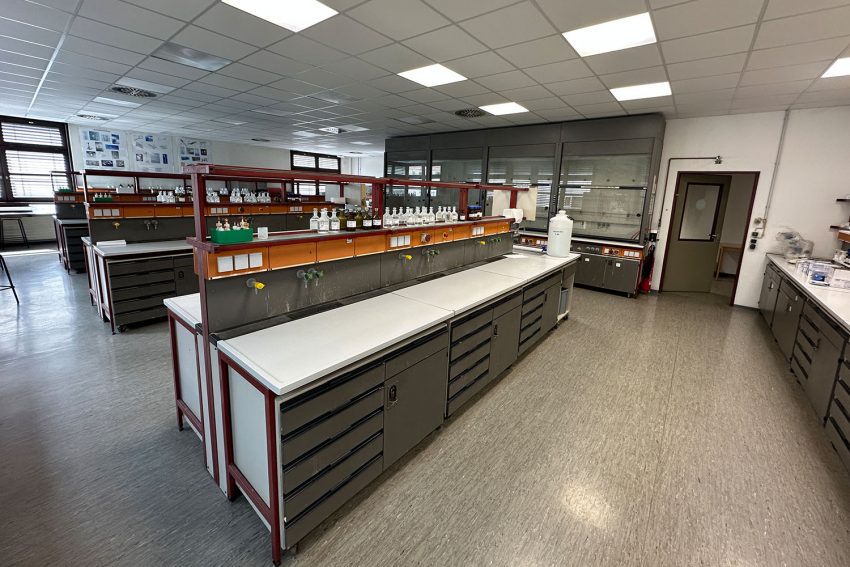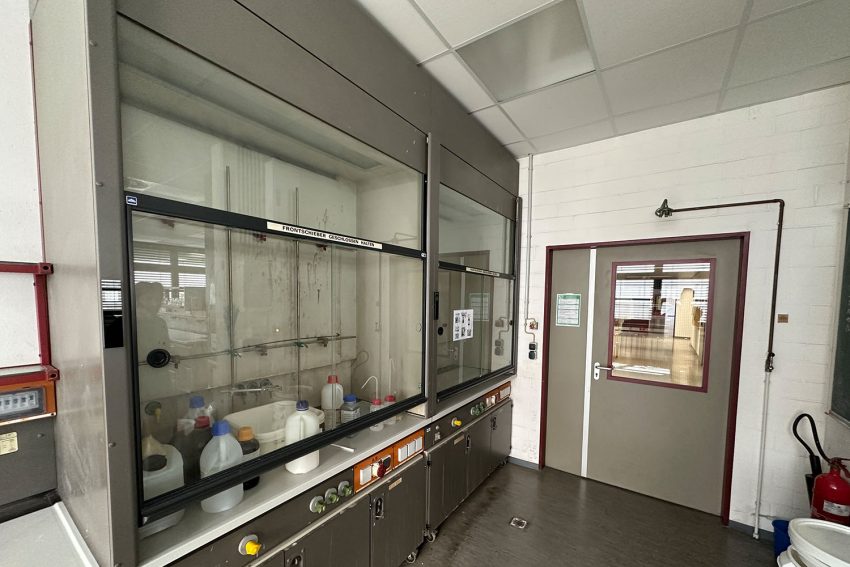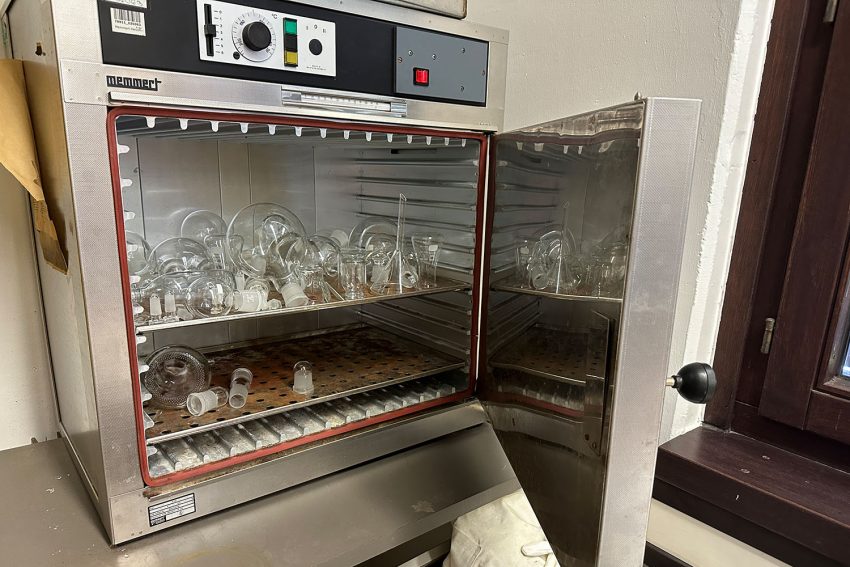Between experiments and savings How the laboratories of TU Braunschweig were able to reduce energy consumption
The state of Lower Saxony is appealing to universities to continue reducing energy consumption, i.e. heat energy and electricity. The Federal Network Agency estimates the gas supply to be stable; with an eye on the coming winter, “economical gas consumption also remains important”[1]. The “alert level” declared by the BMWK in accordance with the Gas Emergency Plan still applies—despite filled storage facilities. The reason: the market situation has not yet normalised. For TU Braunschweig, this means maintaining efforts to save energy—even in summer—in order to avert an energy cost crisis and strengthen the aspect of sustainability. How can this be achieved in particularly energy-intensive research buildings, such as laboratories in the Biology Centre on Spielmannstraße and the Chemistry Centre on Hagenring?

The model laboratory in the Chemistry Centre on Hagenring. Here, a ventilation system ensures that the air is exchanged up to eight times an hour. With the upgraded control system, the fume cupboards can now be switched off manually, e.g. when practical courses are not taking place. Photo credit: Mark Winter/TU Braunschweig
Research and teaching in the facilities of the Faculty of Life Sciences is comparatively energy-intensive. After all, large-scale equipment, air-conditioning rooms, ventilation systems and the like are indispensable, sometimes run continuously, and consume a lot of energy. Nevertheless, the Chemistry Centre, Pharmacy, the Bio Centre, the PVZ and the BRICS were able to significantly reduce their heat and electricity consumption in the first half of 2023. The Chemistry Centre on Hagenring, for example, recorded 15.4 percent savings in heat energy consumption and 11.7 percent savings in electricity consumption. The situation is similar at the Bio Centre on Spielmannstrasse. 15.7 per cent in heat energy and 7.8 per cent in electricity consumption were saved here. The energy use coordinators Dr Dirk Baabe, Institute of Inorganic and Analytical Chemistry, and Dr Martin Rothkegel, Zoological Institute, gave us an insight into the energy savings at the Chemistry Centre and the Bio Centre, and explained which measures have led to success.
“The ventilation system is the be-all and end-all”
The two energy utilisation coordinators immediately agree on the biggest energy consumer: “The biggest energy consumer in laboratory operation is the building technology and here in particular the ventilation system,” both explain independently of each other. It exchanges the air in the laboratory eight times an hour and, in addition to the use of digestories (fume cupboards), ensures safe working in the laboratory when handling hazardous substances. It is thus indispensable for ensuring safety in laboratory operations. In winter, the air is additionally heated to maintain the room temperature in cold weather conditions. This increases the energy demand of the system.
With the introduction of energy cost budgeting in 2014 as an instrument for optimising energy consumption in TU Braunschweig facilities, the first savings measures were implemented in the operation of the ventilation systems, which were expanded last year as a result of the legal savings requirements and the increased energy costs.
The ventilation systems in both the Bio Centre and the Chemistry Centre are currently reduced to half their maximum capacity every day from 8 p.m. to 6 a.m., as well as on weekends and during the university’s closed hours. During this time, no experiments are possible in the laboratories. The effects of this measure are expressed, among other things, in an additional effort in the planning of experiments in laboratory operation. Dr Dirk Baabe: “Experiments cannot always be planned so that they are completed punctually at 8 p.m., but normally there are always natural stopping points during longer experiments where breaks can be taken.” On the situation at the Bio Centre, Dr Martin Rothkegel adds, “I’ve had nothing but positive feedback so far. Due to the lowering, it’s not possible to work with hazardous substances in our laboratories at night and on weekends, but this doesn’t put any restrictions on how we conduct most of our experiments.”

Work with hazardous chemicals can be carried out under such fume hoods. They are connected to the building’s own ventilation system. Photo credit: Mark Winter/TU Braunschweig
In addition, modernising the ventilation system offers great potential for saving energy costs, as Henning Hartmann, team leader in energy management at TU Braunschweig, explained in an earlier interview: “In the case of ventilation, which is the most energy-intensive area, the savings are thus often between several hundred thousand and millions of euros over the entire period of operation.” In the Biology Centre, the ventilation system was already replaced a few years ago. In the Chemistry Centre, on the other hand, this modernisation is still pending. However, the first preliminary investigations have already been completed.
Shutting down, dividing or replacing
With large-scale equipment in continuous operation, drying towers and cabinets, climate control and cooling rooms, (deep-freeze) refrigerators and server rooms, there are further savings opportunities that have been identified and optimised by the energy use coordinators. It is always a question of weighing up the benefits against the savings. “Some of the large devices take a longer time to start up. A short shutdown, e.g. at the weekends, often does not make sense here, as the devices would not be ready for use again immediately afterwards,” explains Dr Dirk Baabe.

Drying cabinets are used to dry laboratory materials at approx. 100 degrees Celsius before the next use in order to free them from water residues. Photo credit: Mark Winter/TU Braunschweig
The situation is better for the other energy consumers. For example, climate control or cooling rooms can be shared between several institutes by agreement. In this way, use can be optimised and surplus equipment and rooms can be switched off. “The permanent shutdown of unused climate chambers in the Bio Centre leads to great energy savings. Before the energy shortage began, we used the surpluses this generated from the energy budget to reinvest in building technology. Now we are benefiting from this,” says Dr Martin Rothkegel.
The age of equipment also plays a role in energy consumption. Older refrigerators are a particularly good example. They are nowhere near as energy-efficient as modern appliances. To make matters worse, refrigerator seals become porous over the years due to the storage of chemicals and thus no longer reliably keep the cold inside the refrigerator. Therefore, surpluses from the past years were invested in the acquisition of modern equipment and infrastructure at both the Chemistry and Bio Centres. In addition to the refrigerators mentioned here as examples, the drinking water heating and heat distribution systems at the Chemistry Centre and the lighting systems at the Bio Centre were also modernised.
Each individual continues to be important
Each employee is still asked to pay attention to their individual consumption. This may be relatively low compared to large-scale consumption such as ventilation systems, air-conditioning rooms, etc., but it should still not be neglected. “My office alone was estimated at 3600 kilowatt hours per year in the original energy demand plan. That corresponds to about the annual consumption of a single-family house, which is of course much too high. Through clever savings, this could be reduced to a minimum,” reports Dr Martin Rothkegel. Dr Dirk Baabe also knows how important individual savings are: “However, the real savings achieved in energy consumption will not be reflected in the energy cost budget for the Chemistry Centre. Due to the sharp increase in energy costs, we will probably only close 2023 with a slightly positive budget surplus close to zero.” Thus, it will also be crucial to keep energy consumption as low as possible in the coming months. Regardless of whether it’s large-scale research equipment or our own work computers.
In view of the savings made in recent months, Dietmar Smyrek, Vice President for Human Resources, Finance and Infrastructure, would like to take this opportunity to thank all staff members for their efforts to date: “Thanks to these efforts, which are also associated with restrictions in usage times and comfort, we are able to avoid closing buildings or taking even tougher cost-cutting measures. It enables us to maintain teaching and research operations to the fullest extent. We thank you for so much commitment to saving energy.”
[1] “bleibt auch ein sparsamer Gasverbrauch wichtig”. https://www.bundesnetzagentur.de/DE/Gasversorgung/aktuelle_gasversorgung/_downloads/2023/06_Juni/230629_gaslage.pdf?__blob=publicationFile&v=1
